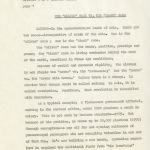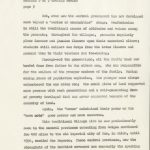1964, October, “The “Silver” Race vs. The “Black” Race”
deepe
article 3 of 7 article series
page 1
THE “SILVER” RACE VS. THE “BLACK” RACE
SAIGON–In the underdeveloped lands of Asia, there are two races–irrespective of color of the skin. One is the “silver” race ; one is the “black” race.
The “silver” race has the money, position, prestige and power; the “black” race is living centuries behind the rest of the world, sometimes in Stone Age conditions.
Because of social and economic rigidity, the slavage is not simple the “haves” vs. the “have-nots;” but the “haves” vs. the “never will haves.” Unless there is a change. In America that change would be called reform; in Asia, it is called revolution. Sometimes, that revolution is identified with Communism.
As a typical example; a Vietnamese government official, working in the customs office, makes 9000 piastres a month in salary. This is not much by Western standards–$125. But because of his position, he makes up to 50,000 piastres ($700) through corruption–a pay off for not opening suitcases of pre-arranged passengers who are smuggling valuables in and out of Viet Nam. He’s now building a new house, spreading rumors that he acquired the additional funds from “the Americans” who in time would lease his old cracker–box abode.
(More)
deepe
article 3 of 7 article series
page 2
His maid, or “boyesse” In Vietnamese-French slang, makes 2000 piastres ($30) a month. A tired, straggly, uneducated woman in her 40’s, she has six children who live on the outskirts of Saigon. She lives in the back of the kitchen of her employer’s house. She gets up at five every morning–the boss wants his coffee at six before going to the office. She’s responsible for the family cooking, housecleaning, floor-scrubbing, marketing, caring for four children. After dinner and until midnight each evening, she washes the family laundry under the dim light on the back porch.
This schedule continues six days a week, Sunday is a “half-day.” She can leave after dinner–about 10 p.m. She does not have enough money for a taxi so she walks to the outskirts of Saigon to see her family, arriving at 11p.m. At four the next morning, she again walks back to work, arriving at five. After all, the boss wants his coffee before work.
A 20-minute taxi ride from Saigon takes one only 15 miles into the countryside–but into a different world existing partially as Vietnamese villagers lived thousands of years ago.
(More)
deepe
article 3 of 7 article series
page 3
The worlds between the capital city and the village seldom meet, which is one of the major problems of the Saigon government.
“The ideas and views of all the government ministeries stops at the suburbs of Saigon,” one American official complained, “as though a giant cordon sealed off the capital.
“Saigon is a symbol of a constipated city. Nothing comes in. Nothing comes out. Nothing circulates. It lacks any ideas–or any initiative to cope with the Communists. Even the ministeries don’t give damn about the provinces.”
In the rural provinces, the differences between the “black” and the “silver” race are camouflaged, but even more complex. The distinction between the two races need not necessarily be money–though large landowning classes have grown up–but it depends on the traditions of an ancient Confucianistic society, which blossomed forth more than 1000 years ago after Chinese invasions.
(More)
deepe
article 3 of 7 article series
page 4
The doctrine of Confucius (551-479 B.C.) framed morality in terms of personal relationships with specified duties and obligations of child to parent, younger brother to elder brother, student to teacher and subject to king. Ancestral worship practiced before family altars in each home symboliwed the basisc allegiance to the family. In Asia, the family might number 100 are includes uncles, aunts, in-laws; in ancient times, as many as five generations lived in one house. (Vietnamese now jokingly call close relatives “cousins of one kilometer”, distant relatives as “cousins of one hundred kilometers.”)
The head of each family was a virtual dictator; each individual was simply a member of the group. A group of families formed a village and became isolated units of government headed by village chiefs and village notables, who parcelled out village land, established rules of communal life, made and enforced the law. Even in ancient times the decrees of the Emperor extended only to the gates of the village. Through the years, the religious aspect of Confucianism blended with other religions; the village became less significant as the central government pushed for more power.
(More)
deepe
article 3 of 7 article series
page 5
But, even now the central government has not developed much beyond a “series of communities” stage. Confucianism is still the traditional source of attitudes and values among the peasants; throughout the villages, peasants regularly place incense and jasmine flowers upon their ancestral altars; students still collect dew drops from the lotus flowers and present them to their teachers for tea-making.
Through-out the generations, all the family land was handed down from father to the eldest son, who was responsible for the welfare of the younger members of the family. During coming years of population explosion, the younger sons always outnumbered the one elder son; the small plots of land supported more persons with each generations and a self-generating form of poverty developed that was never corrected because of the scarcity of land.
Again, the “haves” maintained their power as the “have nots” grew poorer and more numerous.
This traditional village life is now predominantly seen in the central provinces extending from Saigon northward for 400 miles to the old imperial city of Hue, in which, until 1954, resided the Emperor. These central provinces, now the stronghold of the Buddhist movement are currently the sparking the anti-government demonstrations and organizations.
(More)
deepe
article 3 of 7 article series
page 6
It’s hardly an accident that these strongly traditional, strongly authoritarian areas are also the most revolutionary–many leaders of the Communist North Vietnamese regime were born in these poor areas.
It is from the rural areas like these that the young men join the Communist guerrillas or the subversive political cells. But the traditions of history, family life and ancestral traditions are also an obstacle for the Communist revolution.
“Given the choice between fighting and notfighting , the Vietnamese peasant would choose not to fight,” one Western diplomat explained.
“But few have that choice. Given the preference of fighting for the government or for the Communists, the peasant would go to the Communist side. He’s been indoctrinated by Communist political cadre for years–and the Communist troops are always in his area.”
This hardly means the young recruits of the Communists are revolutionaries–but neither are they satisfied with the status quo offered by the American-backed Saigon government.
(More)
deepe
article 3 of 7 article series
page 7
“The people are caught between two vermin,” one peasant farmer southwest of Saigon complained bitterly. “The Communists make us dig up the road by night; the government troops make fill it in by day. The government forces them to put up barbed wire fences; the Communists force us to tear it town. The government comes to us for taxes; the Communists for rice and chicken. We can not win.”
One villager could not win was Phan Thi Thanh 25, from the small village of Huynh Lien, 400 miles north of Saigon. Her mother died when she was 16, her two elder brothers went to North Viet Nam with the Communist guerrillas at the close of the French Indo-China War, in 1954.
She lived with her deaf, blind father, 78-years-old, who complained one day: “My sons have been gone for ten years and their wives are not like daughters any more. We can not give them orders like before. If they come to see us, they come; if they don’t come, they don’t.”
Miss Tanh told her unhappy story: “One night, thirty Viet Cong (Communist) guerrillas came to her hamlet with rifles and grenades,” she complained, cupping around her drolled cigarette. “They asked the people to assemble. There are about 80 to 90 adults in the hamlet; about 60-70 of these are women. The women are two-thirds of the population because the men are in the army or elsewhere.
(More)
deepe
article 3 of 7 article series
page 8
The people told the Viet Cong: If you come here the national army will come and kill us.
The Viet Cong replied: Don’t be afraid; we have soldiers to protect us.”
For four consecutive nights–the village assembled and made demonstration, she said in the daytimes it destroyed the government strategic hamlet (the fortified hamlets established by the government, supposedly the keystone of the pacification effort). Villagers during the day tore down the bamboo fences and the Viet Cong rolled up the barbed wire fences.
The strategic hamlet had been set up 2 years go; Miss Thanh said; she had helped work on it, digging trenches, picking bamboo and making it into poles and plunging them into the ground for the fences.
The government gave the hamlet several thousand piastres ($US30) for this work and she had received 40 piastres (6 cents).
But the hamlet was considered an area which had lost its security. There had been a hamlet chief, but two months earlier he was frightened and went to live in the village center and stayed with the village council. His assistant in charge of security was kidnapped by the Viet Cong and the vilagees had heard nothing about him since.
(More)
deepe
article 3 of 7 article series
page 9
Miss Thanh said: The village used to have combat youth, too, trained by the government for one moth and given rifles and a radio to defend the hamlet. However, a few months before, they were dissolved so they gave their rifles and radio back to the village council. When the Viet Cong came to the hamlet, they asked three combat youth to join them and gave them weapons. These three were later killed in the big battle.
“Then one night, the Viet Cong asked me to round up the women to come to a meeting in one of the family’s houses.” Miss Thanh explained: “There are about 60 women in the hamlet, but only 30 came to the meeting–the others were busy with their children. One Viet Cong soldier with a rifle kept watch outside the house and sometimes he’d look into the meeting.
“At the beginning of the meeting, the cadre said that with the revolution the Viet Cong must liberate the women so the have their deserved place. He said they would organize a committee of women in order to guide the women and lead their activities. He asked who would b3e elceelected and suggested two capable cadre; one named Huong and the other was me.
The cadre he appointed Huong as chairman and me as vice-chairman.
I was not very happy or proud and I told the cadre that. I said I didn’t want to accept. It would be dangerous; the national army could come and beat me.”
(More)
deepe
article 3 of 7 article series
page 10
One day the government troops ordered the village Miss Thanh said she fled to a nearby hamlet. On the first day, cannonshells fell on the hamlet; no one was killed, but everyone was terrified, she said four days later said she returned to her hamlet, and at 9 in the morning the government troops came to her hamlet.
“At first I was scared and stayed in the trench in my house,” Miss Thanh said: “But when the Viet Cong fled, I asked them to take me along. They were not very happy to take me, but didn’t force me to stay. I told them I wanted to go because I was elected vice-chairman of the Women’s Association and if I stayed the government would arrest and torture me. So I said I was going with them.
“The Viet Cong fled towards the river and the national army was coming from the other side. There was a lot of shooting. When it ended, eight Viet Cong were dead. One was the chairman of the women’s committee. I was shot in the finger and captured. The government said I was a Viet Cong , a liaison agent.”
A high-ranking military officer said she would be executed.
-30-
Read Previous Article: 1964, October, “The War of Termites and Shadows”
Read Next Article: 1964, October, “The Air-Conditioned Monk”










